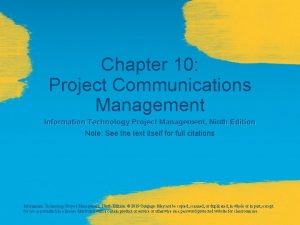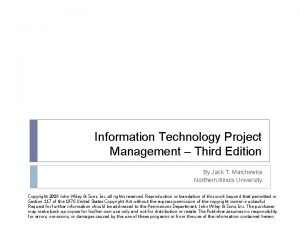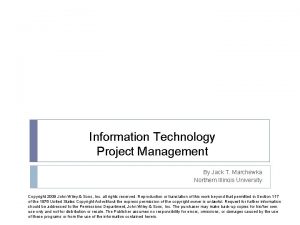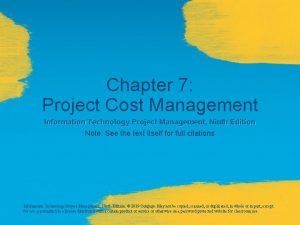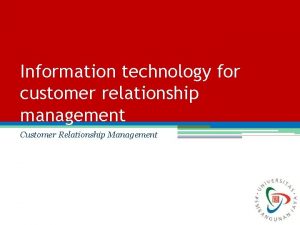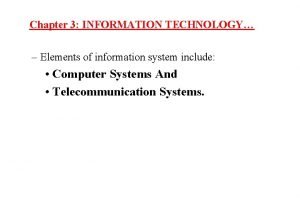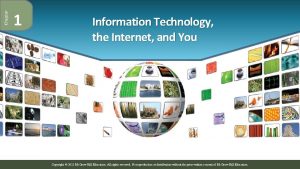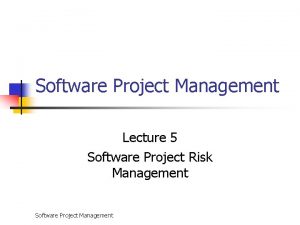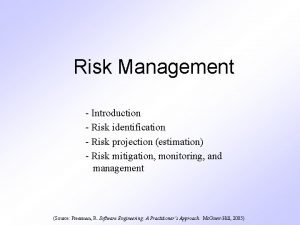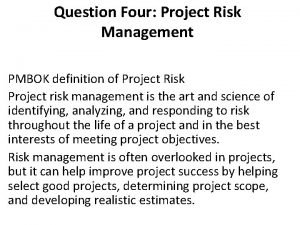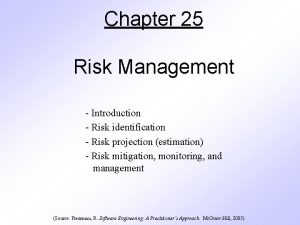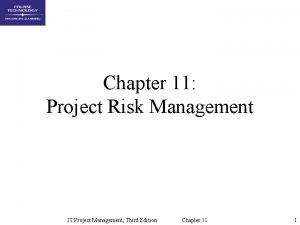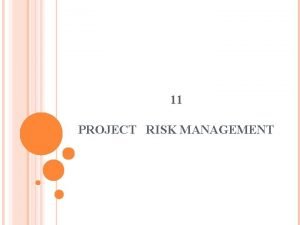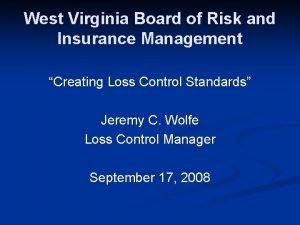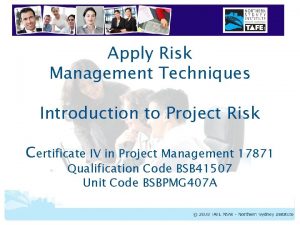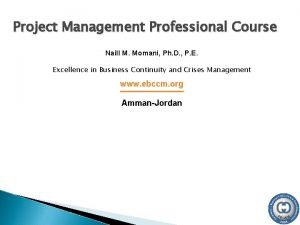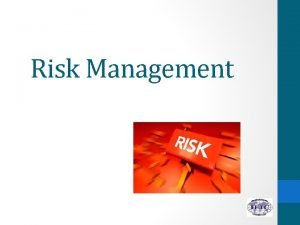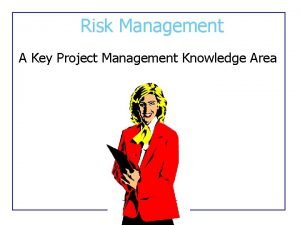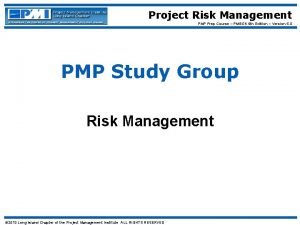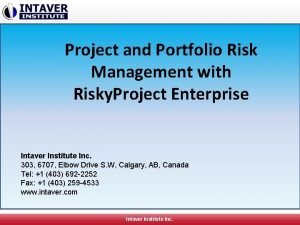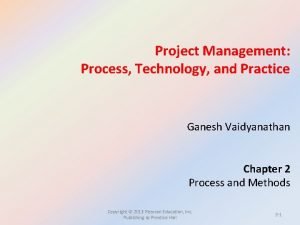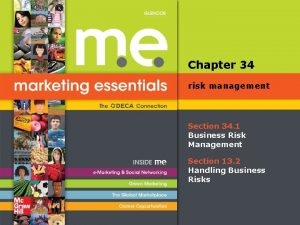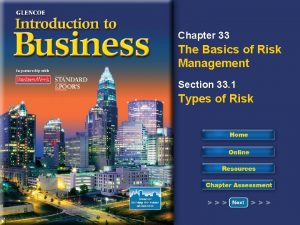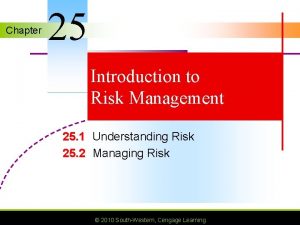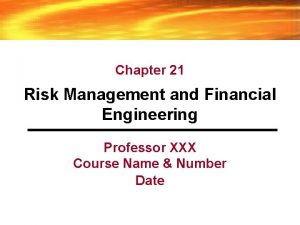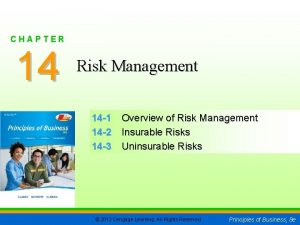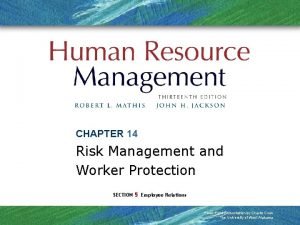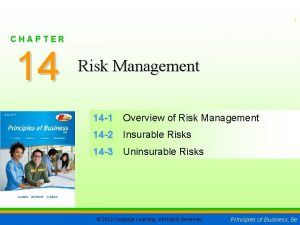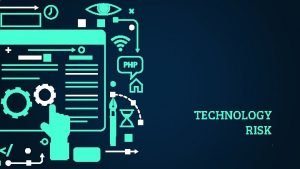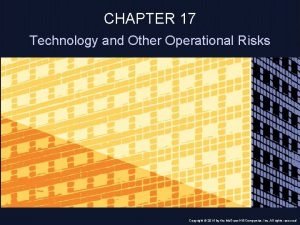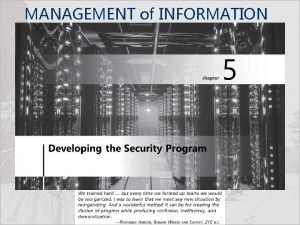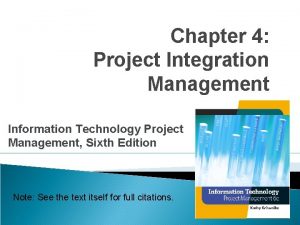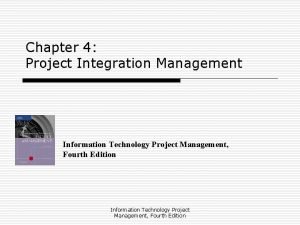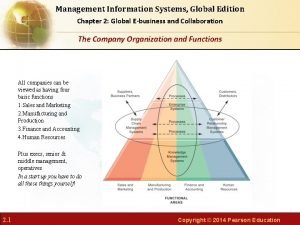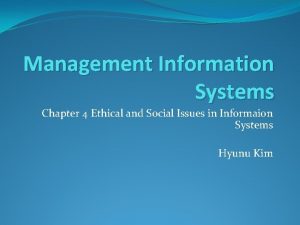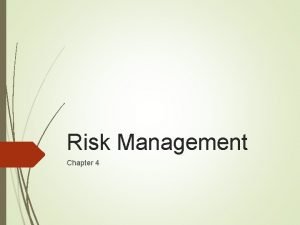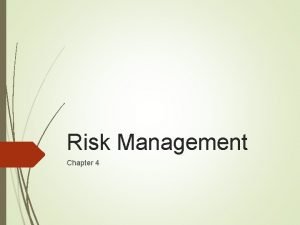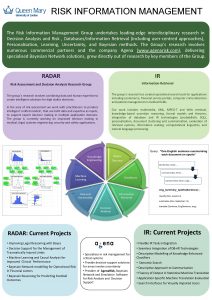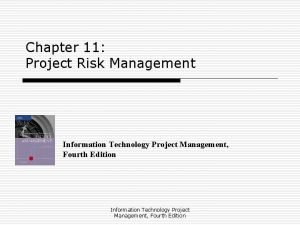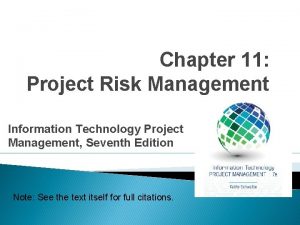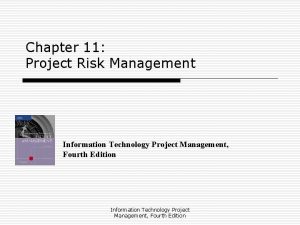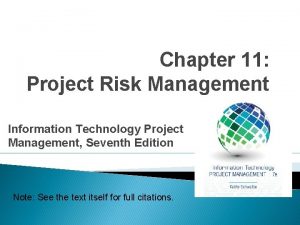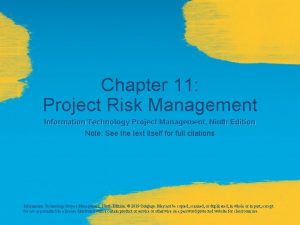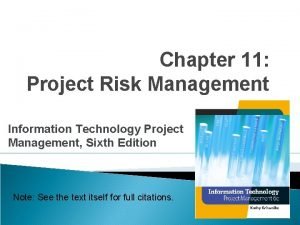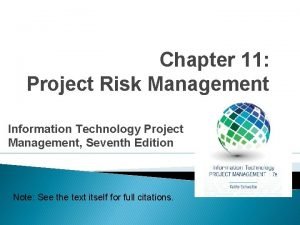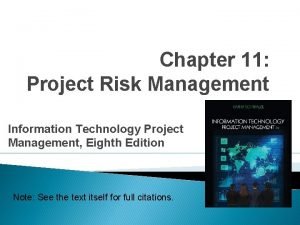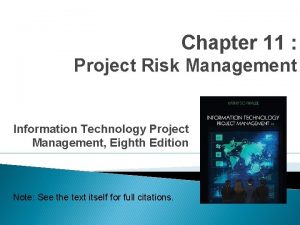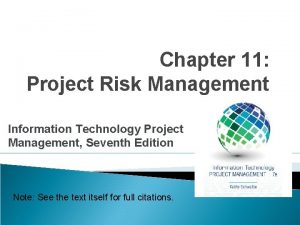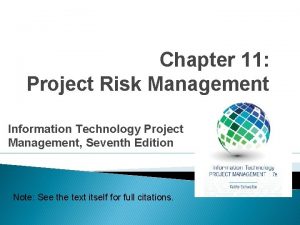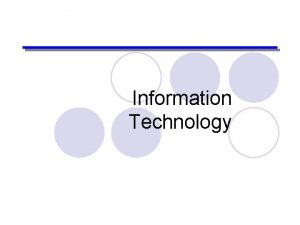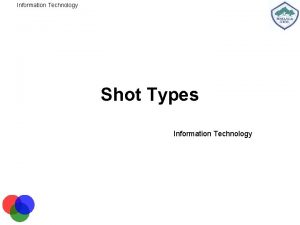Chapter 11 Project Risk Management Information Technology Project
































































- Slides: 64

Chapter 11: Project Risk Management Information Technology Project Management, Fifth Edition

Learning Objectives Understand what risk is and the importance of good project risk management Discuss the elements involved in risk management planning and the contents of a risk management plan List common sources of risks in information technology projects 2 Chapter 11 – Project Risk Management

Learning Objectives (continued) Describe the risk identification process, tools and techniques to help identify project risks, and the main output of risk identification: a risk register Discuss the qualitative risk analysis process and explain how to calculate risk factors, create probability/impact matrixes, and apply the Top Ten Risk Item Tracking technique to rank risks 3 Chapter 11 – Project Risk Management

Learning Objectives (continued) Explain the quantitative risk analysis process and how to apply decision trees, simulation, and sensitivity analysis to quantify risks Provide examples of using different risk response planning strategies to address both negative and positive risks Discuss what is involved in risk monitoring and control Describe how software can assist in project risk management 4 Chapter 11 – Project Risk Management

The Importance of Project Risk Management Project risk management is the art and science of identifying, analyzing, and responding to risk throughout the life of a project and in the best interests of meeting project objectives Risk management is often overlooked in projects, but it can help improve project success by helping select good projects, determining project scope, and developing realistic estimates Unfortunately, crisis management has higher visibility due to the obvious danger to the success of the project but it’s risk management that helps a project have fewer problems to begin with. 5 Chapter 11 – Project Risk Management

Research Shows Need to Improve Project Risk Management Study by Ibbs and Kwak shows risk has the lowest maturity rating of all knowledge areas A similar survey was completed with software development companies in Mauritius, South Africa in 2003, and risk management also had the lowest maturity (1. 84 vs average of 2. 29) A KLCI Research Group study (2001) shows the benefits of following good software risk management practices 97% had procedures to identify and asess risk 80% identified anticipating and avoiding problems as the 6 primary benefit of risk management 70% had defined s/w development processes 64% has a Project Management Office Chapter 11 – Project Risk Management

Project Management Maturity by Industry Group and Knowledge Area* KEY: 1 = LOWEST MATURITY RATING 5 = HIGHEST MATURITY RATING Telecommunications Knowledge Area Engineering/ Construction Information Systems Hi-Tech Manufacturing Scope 3. 52 3. 45 3. 25 3. 37 Time 3. 55 3. 41 3. 03 3. 50 Cost 3. 74 3. 22 3. 20 3. 97 Quality 2. 91 3. 22 2. 88 3. 26 Human Resources 3. 18 3. 20 2. 93 3. 18 Communications 3. 53 3. 21 3. 48 Risk 2. 93 2. 87 2. 75 2. 76 Procurement 3. 33 3. 01 2. 91 3. 33 *Ibbs, C. William and Young Hoon Kwak. “Assessing Project Management Maturity, ” Project Management Journal (March 2000). 7 Chapter 11 – Project Risk Management

Benefits from Software Risk Management Practices* 8 *Kulik, Peter and Catherine Weber, “Software Risk Management Practices – 2001, ” KLCI Research Group (August 2001). Chapter 11 – Project Risk Management

Negative Risk A dictionary definition of risk is “the possibility of loss or injury” Negative risk involves understanding potential problems that might occur in the project and how they might impede project success Negative risk management is like a form of insurance; it is an investment If IT projects are so risky, why do companies pursue them? 9 Chapter 11 – Project Risk Management

Risk Can Be Positive risks are risks that result in good things happening; sometimes called opportunities A general definition of project risk is an uncertainty that can have a negative or positive effect on meeting project objectives The goal of project risk management is to minimize potential negative risks while maximizing potential positive risks 10 Chapter 11 – Information Technology Project Management, Fifth Edition, Copyright 2007 Project Risk Management

Best Practice Some organizations make the mistake of only addressing tactical and negative risks when performing project risk management David Hillson (www. risk-doctor. com) suggests overcoming this problem by widening the scope of risk management to encompass both strategic risks and upside opportunities, which he refers to as integrated risk management Ensure that project delivery is tied to organizational 11 needs and vision Allowing an appropriate level of risk to be taken intelligently with full awareness of the degree of uncertainty and its potential effects on objectives Chapter 11 – Project Risk Management

Risk Utility Different organizations and people have different tolerances for risk Risk utility or risk tolerance is the amount of satisfaction or pleasure received from a potential payoff Utility rises at a decreasing rate for people who are risk- averse Those who are risk-seeking have a higher tolerance for risk and their satisfaction increases when more payoff is at stake The risk-neutral approach achieves a balance between risk and payoff 12 Chapter 11 – Project Risk Management

Risk Utility Function and Risk Preference 13 Chapter 11 – Project Risk Management

Project Risk Management Processes Risk management planning: deciding how to approach and plan the risk management activities for the project Risk identification: determining which risks are likely to affect a project and documenting the characteristics of each Qualitative risk analysis: prioritizing risks based on their probability and impact of occurrence 14 Chapter 11 – Project Risk Management

Project Risk Management Processes Quantitative risk analysis: numerically estimating the effects of risks on project objectives Risk response planning: taking steps to enhance opportunities and reduce threats to meeting project objectives Risk monitoring and control: monitoring identified and residual risks, identifying new risks, carrying out risk response plans, and evaluating the effectiveness of risk strategies throughout the life of the project 15 Chapter 11 – Project Risk Management

Project Risk Management Summary 16 Chapter 11 – Project Risk Management

Risk Management Planning The main output of risk management planning is a risk management plan—a plan that documents the procedures for managing risk throughout a project The project team should review project documents, corporate risk management policies, lessonslearned reports from past projects and understand the organization’s and the sponsor’s approaches to risk Important to clarify roles and responsibilities, prepare budget and schedule estimates for risk-related work and identify risk categories for consideration The level of detail will vary with the needs of the 17 project Chapter 11 – Project Risk Management

Topics Addressed in a Risk Management Plan Methodology: How will risk management be performed on this project? What tools and data sources are available and applicable? Roles and Responsibilities: Who are the individuals responsible for implementing specific tasks and providing deliverables related to risk management? Budget and Schedule: What are the estimated costs and schedules for performing risk-related activities? Risk Categories: What are the main categories of risks that should be addressed on this project? Is there a risk breakdown structure for the project? Risk Probability and Impact: How will the probabilities and impacts of risk items be assessed? What scoring and interpretation methods will be used for the qualitative and quantitative analysis of risks? Risk Documentation: What reporting formats and processes will 18 be used for risk management activities? Chapter 11 – Project Risk Management

Contingency and Fallback Plans, Contingency Reserves In addition to a risk management plan, many projects also include: Contingency plans – predefined actions that the project team will take if an identified risk event occurs Expecting new release of a s/w package, must plan to use older version if delayed Fallback plans - developed for risks that have a high impact on meeting project objectives, and are put into effect if attempts to reduce the risk are not effective College grad has main plan and contingency plans of where to live after graduation but needs fallback plan to possibly live at home Contingency reserves or allowances - provisions held by the project sponsor or organization to reduce the risk of cost or schedule overruns to an acceptable level Project falling behind schedule due to inexperience with new 19 technology, use these funds to hire outside trainer Chapter 11 – Project Risk Management

Common Sources of Risk in Information Technology Projects Several studies show that IT projects share some common sources of risk The Standish Group developed an IT success potential scoring sheet (next slide) based on potential risks If a potential project does not receive a minimum score, the organization might decide not to work on it or to take actions to reduce the risks before it invests too much time or money The Standish Group developed specific questions for each success criterion to help decide the number of points to assign to a project User Involvement: Do I have the right users? Did I involve the users early on? Do I make involvement easy? … 20 Chapter 11 – Project Risk Management

Information Technology Success Potential Scoring Sheet The number of questions corresponding to each success criterion determines the number of points each positive response is assigned Ex: User involvement: 19/5 (or 3. 8) points per question answered positively 21 Chapter 11 – Project Risk Management

Broad Categories of Risk Many organizations develop their own risk questionnaires. Some of the categories of risk might include: Market risk – Will the new service or product be useful to the 22 organization or marketable to others? Will the users accept it? Will someone else create a better product? Financial risk – can the organization afford to undertake the project? Will the project meet NPV, ROI and payback estimates? Technology risk – is the project technically feasible? Is it leading edge or bleeding edge technology? People risk – Are people with appropriate skills available to help complete the project? Does senior management support the project? Structure/process risk – What is the degree of change the new project will introduce into user areas and business procedures? With how many other systems does a new project/system need to interact? Chapter 11 – Project Risk Management

What Went Wrong? KPMG, a large consulting firm, published a study in 1995 that found that 55 percent of runaway projects— projects that have significant cost or schedule overruns —did no risk management at all; 38 percent did some (but half did not use their risk findings after the project was underway); and 7 percent did not know whether they did risk management or not The timing of risk management is also an important consideration Comair delayed replacing a legacy system that managed flight crews and, when it eventually crashed over the holidays, 3, 900 flights were cancelled, 200, 000 passengers were stranded and ran up a tab of $20 million. 23 Chapter 11 – Information Technology Project Management, Fifth Edition, Copyright 2007 Project Risk Management

Risk Breakdown Structure A risk breakdown structure is a hierarchy of potential risk categories for a project Similar to a work breakdown structure but used to identify and categorize risks In addition to identifying risk based on the nature of the project or products produced, it is also important to identify potential risks according to project management knowledge areas 24 Chapter 11 – Project Risk Management

Sample Risk Breakdown Structure 25 Chapter 11 – Project Risk Management

Potential Negative Risk Conditions Associated With Each Knowledge Area 26 Chapter 11 – Project Risk Management

Risk Identification Risk identification is the process of understanding what potential events might hurt or enhance a particular project This is an ongoing process throughout the project lifecycle as things change You can not manage risks that you don’t identify Risk identification tools and techniques include: Brainstorming The Delphi Technique Interviewing SWOT analysis 27 Chapter 11 – Project Risk Management

Brainstorming is a technique by which a group attempts to generate ideas or find a solution for a specific problem by amassing ideas spontaneously and without judgment An experienced facilitator should run the brainstorming session Be careful not to overuse or misuse brainstorming Psychology literature shows that individuals produce a greater number of ideas working alone than they do through brainstorming in small, face-to-face groups Group effects often inhibit idea generation 28 Chapter 11 – Project Risk Management

Delphi Technique The Delphi Technique is used to derive a consensus among a panel of experts who make predictions about future developments Developed by the RAND Corporation for the US Air Force in the late 1960 s Provides independent and anonymous input regarding future events Uses repeated rounds of questioning and written responses and avoids the biasing effects possible in oral methods, such as brainstorming Requires a panel of experts for the particular area in question 29 Chapter 11 – Project Risk Management

Interviewing is a fact-finding technique for collecting information in face-to-face, phone, e-mail, or instant-messaging discussions Useful to have a prepared set of questions as a guide to the interview Interviewing people with similar project experience is an important tool for identifying potential risks 30 Chapter 11 – Project Risk Management

SWOT Analysis SWOT analysis (strengths, weaknesses, opportunities, and threats) can also be used during risk identification Project teams focus on the broad perspectives of potential risks for particular projects What are the company’s strengths and weaknesses related to this project What opportunities and threats exist Helps identify the broad negative and positive risks that apply to a project 31 Chapter 11 – Project Risk Management

Other Risk Identification Methods Checklists based on risks encountered in previous projects Analyze the validity of project assumptions as incomplete, inaccurate and/or inconsistent assumptions can lead to identifying more risks Diagramming techniques: cause-and-effect, fishbone, flowcharts and influence diagrams Influence diagrams represent decision problems by displaying essential elements, including decisions, uncertainties, causality and objectives and how they influence each other (www. lumina. com/software/influencediagrams. html) 32 Chapter 11 – Project Risk Management

Other Risk Identification Methods An influence diagram is a simple visual representation of a decision problem. Influence diagrams offer an intuitive way to identify and display the essential elements, including decisions, uncertainties, and objectives, and how they influence each other. This simple influence diagram shows how decisions about the marketing budget and product price influence expectations about its uncertain market size and market share. These, in turn, influence costs and revenues, which affect the overall profit. The product manager, VP of marketing, and market analyst may work together to draw such a diagram to develop a shared understanding of the key issues. The diagram provides a high-level qualitative view under which the analyst builds a detailed quantitative model. 33 Chapter 11 – Project Risk Management

Other Risk Identification Methods A decision is a variable that you, as the decision maker, have the power to control. A chance variable is uncertain and you cannot control it directly. An objective variable is a quantitative criterion that you are trying to maximize (or minimize). A general variable is a deterministic function of the quantities it depends on. 34 Chapter 11 – Project Risk Management An arrow denotes an influence. A influences B means that knowing A would directly affect our belief or expectation about the value of B. An influence expresses knowledge about relevance. It does not necessarily imply a causal relation, or a flow of material, data, or money.

Risk Register The main output of the risk identification process is a list of identified risks and other information needed to begin creating a risk register A risk register is: A document that contains the results of various risk management processes and that is often displayed in a table or spreadsheet format A tool for documenting potential risk events and related information Risk events refer to specific, uncertain events that may occur to the detriment or enhancement of the project Negative risks: delays in completing work as scheduled, increases in 35 estimated costs, supply shortages, litigation, strikes, etc. Positive risks: completing work sooner and/or cheaper than planned, collaborating with suppliers to produce better products, good publicity, etc. Chapter 11 – Project Risk Management

Risk Register Contents An identification number for each risk event A rank for each risk event The name of each risk event A description of each risk event The category under which each risk event falls The root cause of each risk 36 Chapter 11 – Information Technology Project Management, Fifth Edition, Copyright 2007 Project Risk Management

Risk Register Contents (continued) Triggers for each risk; triggers are indicators or symptoms of actual risk events Cost overruns on early activities, defective products Potential responses to each risk The risk owner or person who will own or take responsibility for each risk The probability and impact of each risk occurring The status of each risk 37 Chapter 11 – Project Risk Management

Sample Risk Register 38 Chapter 11 – Project Risk Management

Qualitative Risk Analysis After identifying risks, the next step is to understand which risks are most important Assess the likelihood and impact of identified risks to determine their magnitude and priority Risk quantification tools and techniques include: Probability/impact matrixes The Top Ten Risk Item Tracking Expert judgment 39 Chapter 11 – Project Risk Management

Probability/Impact Matrix A probability/impact matrix or chart lists the relative probability of a risk occurring on one side of a matrix or axis on a chart and the relative impact of the risk occurring on the other List the risks and then label each one as high, medium, or low in terms of its probability of occurrence and its impact if it did occur Deal first with those risks in the high probability/high impact cell 40 Chapter 11 – Project Risk Management

Sample Probability/Impact Matrix 41 Chapter 11 – Project Risk Management

Risk factors Can also calculate risk factors Numbers that represent the overall risk of specific events based on their probability of occurring and the consequences to the project if they do occur Probabilities of a risk occurring can be estimated based on several factors based on the unique nature of each project For example: technology not being mature, technology too complex, inadequate support base for developing the technology The impact of a risk could include factors such as the availability of fallback solutions or the consequences of not meeting performance, cost and schedule estimates 42 Chapter 11 – Project Risk Management

High-, Medium-, and Low-Risk Technologies Example of how risk factors were used to graph the probability of failure and consequence of failure for proposed technologies in a research study to help design more reliable aircraft Based on this chart, the recommendation was made to invest in low- to medium-risk technologies and not pursue high-risk technology 43 Chapter 11 – Project Risk Management

Top Ten Risk Item Tracking is a qualitative risk analysis tool that helps to identify risks and maintain an awareness of risks throughout the life of a project Establish a periodic review of the top ten project risk items List the current ranking, previous ranking, number of times the risk appears on the list over a period of time, and a summary of progress made in resolving the risk item 44 Chapter 11 – Project Risk Management

Top Ten Risk Item Tracking Keeps management and the customer aware of the major influences that could prevent or enhance the project’s success By involving the customer, the project team may be able to consider alternative strategies for addressing the risks It’s a means of promoting confidence in the project team by demonstrating to management and the customer that the team is aware of the significant risks, has a strategy in place and is effectively carrying out that strategy 45 Chapter 11 – Project Risk Management

Example of Top Ten Risk Item Tracking 46 Chapter 11 – Project Risk Management

Watch List A watch list is a list of risks that are low priority, but are still identified as potential risks Qualitative analysis can also identify risks that should be evaluated on a quantitative basis 47 Chapter 11 – Project Risk Management

Quantitative Risk Analysis Often follows qualitative risk analysis, but both can be done together Large, complex projects involving leading edge technologies often require extensive quantitative risk analysis Main techniques include: Decision tree analysis Simulation Sensitivity analysis 48 Chapter 11 – Project Risk Management

Decision Trees and Expected Monetary Value (EMV) A decision tree is a diagramming analysis technique used to help select the best course of action in situations in which future outcomes are uncertain Estimated monetary value (EMV) is the product of a risk event probability and the risk event’s monetary value You can draw a decision tree to help find the EMV 49 Chapter 11 – Project Risk Management

Expected Monetary Value (EMV) 50 Chapter 11 – Project Risk Management

Simulation uses a representation or model of a system to analyze the expected behavior or performance of the system To use a Monte Carlo simulation, you must have three estimates (most likely, pessimistic, and optimistic) plus an estimate of the likelihood of the estimate being between the most likely and optimistic values Monte Carlo analysis simulates a model’s outcome many times to provide a statistical distribution of the calculated results Predicts the probability of finishing by a certain date or that the cost will be equal to or less than a certain value 51 Chapter 11 – Project Risk Management

Steps of a Monte Carlo Analysis 1. 2. Assess the range for the variables being considered – gather most likely, optimistic and pessimistic time estimates for each task Determine the probability distribution of each variable 1. Optimistic 8 weeks, most likely 10 and pessimistic 15 3. For each variable, select a random value based on the probability distribution 1. 20% chance between 8 and 10 weeks, 80% between 10 and 15 4. 5. Run a deterministic analysis or one pass through the model Repeat steps 3 and 4 many times to obtain the probability distribution of the model’s results – usually between 100 to 1, 000 iterations 52 Chapter 11 – Project Risk Management

Sample Monte Carlo Simulation Results for Project Schedule 53 Chapter 11 – Project Risk Management

What Went Right? A large aerospace company used Monte Carlo simulation to help quantify risks on several advanceddesign engineering projects, such as the National Aerospace Plan (NASP) Design a vehicle that could fly into space using a single- 54 stage-to-orbit approach The results of the simulation were used to determine how the company would invest its internal research and development funds Although the NASP project was terminated, the resulting research has helped develop more advanced materials and propulsion systems used on many modern aircraft Eli Lily uses simulation to determine the optimal plant capacity that should be built for each drug Chapter 11 – Project Risk Management

Sensitivity Analysis Sensitivity analysis is a technique used to show the effects of changing one or more variables on an outcome For example, many people use it to determine what the monthly payments for a loan will be given different interest rates or periods of the loan, or for determining break-even points based on different assumptions Spreadsheet software, such as Excel, is a common tool for performing sensitivity analysis 55 Chapter 11 – Project Risk Management

Sample Sensitivity Analysis for Determining Break-Even Point 56 Chapter 11 – Project Risk Management

Risk Response Planning After identifying and quantifying risks, you must decide how to respond to them Four main response strategies for negative risks: Risk avoidance – don’t use h/w or s/w if unfamiliar with them Risk acceptance – prepare for risk with backup plan or contingency reserves Risk transference – to deal with financial risk exposure, a company may purchase special insurance for specific h/w needed for a project. If h/w fails, insurer has to replace it. Risk mitigation – reduce probability of occurrence e. g. , use proven technology, buy maintenance or service contract 57 Chapter 11 – Project Risk Management

General Risk Mitigation Strategies for Technical, Cost, and Schedule Risks 58 Chapter 11 – Project Risk Management

Response Strategies for Positive Risks Risk exploitation – do whatever you can to make sure the risk occurs, call press conference to advertise new product, take out ads, etc Risk sharing – allocating ownership of the risk to another party. Hire an outside firm to do your advertising and PR Risk enhancement – identify and maximize key drivers of the risk. Encourage your employees or users of your product to spread the word of your product Risk acceptance – don’t take any action with regard to positive risk. Assume the product will 59 speak for itself Chapter 11 – Project Risk Management

Residual and Secondary Risks It’s also important to identify residual and secondary risks Residual risks are risks that remain after all of the response strategies have been implemented Even though used stable h/w platform, it still may fail Secondary risks are a direct result of implementing a risk response Using stable h/w may have caused a risk of peripheral devices failing to function properly 60 Chapter 11 – Project Risk Management

Media Snapshot A highly publicized example of a risk response to corporate financial scandals, such as those affecting Enron, Arthur Andersen, and World. Com, was legal action The Sarbanes-Oxley Act is considered the most significant change to federal securities laws in the United States since the New Deal Fines, prison sentences up to 20 years for anyone who knowingly alters or destroys a record or document with the intent to obstruct an investigation This Act has caused many organizations to initiate projects and other actions to avoid litigation 61 Chapter 11 – Project Risk Management

Risk Monitoring and Control Involves executing the risk management process to respond to risk events This is an ongoing activity – new risks identified, old risks disappear, weaken or get stronger Workarounds are unplanned responses to risk events that must be done when there are no contingency plans Main outputs of risk monitoring and control are: Requested changes Recommended corrective and preventive actions Updates to the risk register, project management plan, and organizational process assets 62 Chapter 11 – Project Risk Management

Using Software to Assist in Project Risk Management Risk registers can be created in a simple Word or Excel file or as part of a database More sophisticated risk management software, such as Monte Carlo simulation tools, help in analyzing project risks The PMI Risk Specific Interest Group’s Web site at www. risksig. com has a detailed list of software products to assist in risk management 63 Chapter 11 – Project Risk Management

Results of Good Project Risk Management Unlike crisis management, good project risk management often goes unnoticed Well-run projects appear to be almost effortless, but a lot of work goes into running a project well Project managers should strive to make their jobs look easy to reflect the results of well-run projects 64 Chapter 11 – Project Risk Management
 Market risk credit risk operational risk
Market risk credit risk operational risk Information technology project management 9th edition
Information technology project management 9th edition Information technology project management 9th edition ppt
Information technology project management 9th edition ppt Project management quality control
Project management quality control Information technology project management 9th edition
Information technology project management 9th edition Information technology project management 9th edition
Information technology project management 9th edition Information technology project management
Information technology project management Information technology project management
Information technology project management Key risk indicators template
Key risk indicators template Risk map risk management
Risk map risk management Traditional vs modern project management
Traditional vs modern project management Definitive estimate range
Definitive estimate range Enterprise and global management
Enterprise and global management Information technology resource management
Information technology resource management Crm and information technology
Crm and information technology Information technology chapter 3
Information technology chapter 3 Chapter 1 information technology the internet and you
Chapter 1 information technology the internet and you Chapter 1 information technology the internet and you
Chapter 1 information technology the internet and you Software project risk
Software project risk Risk projection in software engineering
Risk projection in software engineering Pmi risk management definition
Pmi risk management definition Risk mitigation techniques in project management
Risk mitigation techniques in project management Risk categories in project management
Risk categories in project management Risk assessment project example
Risk assessment project example Project risk management adalah
Project risk management adalah West virginia board of risk and insurance management
West virginia board of risk and insurance management Introduction to project risk management
Introduction to project risk management Project risk management
Project risk management Four stages of risk management
Four stages of risk management What is risk management in a project
What is risk management in a project Pmbok
Pmbok Project and portfolio risk management software
Project and portfolio risk management software Project management process technology and practice
Project management process technology and practice Financial management chapter 8 risk and return
Financial management chapter 8 risk and return Chapter 34 risk management
Chapter 34 risk management Chapter 33 the basics of risk management
Chapter 33 the basics of risk management Chapter 25 introduction to risk management
Chapter 25 introduction to risk management Chapter 21 introduction to risk management
Chapter 21 introduction to risk management Chapter 14 risk management answer key
Chapter 14 risk management answer key Chapter 14 risk management
Chapter 14 risk management Chapter 14 risk management
Chapter 14 risk management What is risk projection in software engineering
What is risk projection in software engineering Risk avoidance insurance
Risk avoidance insurance Relative risk calculation
Relative risk calculation Residual risk and secondary risk pmp
Residual risk and secondary risk pmp Ar = ir x cr x dr
Ar = ir x cr x dr Absolute risk vs relative risk
Absolute risk vs relative risk Activity sheet 2 stock market calculations answer key
Activity sheet 2 stock market calculations answer key Firm risk scorecard risk classification system
Firm risk scorecard risk classification system Risk financing retention adalah
Risk financing retention adalah The biggest risk is not taking any risk
The biggest risk is not taking any risk Business risk vs audit risk
Business risk vs audit risk Business vs financial risk
Business vs financial risk Relative risk calculation
Relative risk calculation Relative risk
Relative risk Technology risk definition
Technology risk definition Technology and other operational risks
Technology and other operational risks Project management for information security
Project management for information security Project management information system example
Project management information system example Project management information system example
Project management information system example Management information system chapter 2
Management information system chapter 2 Mis chapter 3
Mis chapter 3 Management information system chapter 4
Management information system chapter 4 Management information system chapter 1
Management information system chapter 1 Chapter 9 information management and security
Chapter 9 information management and security





